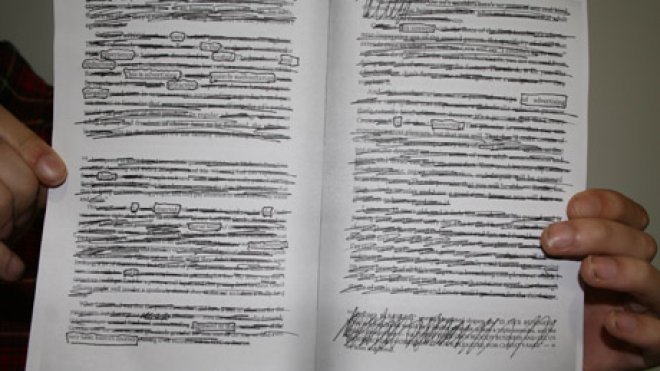Reinventing the Written Word in Found Poetry
Cut-and-paste and erasure creations render new poetic works from familiar texts

BRISTOL, R.I. – Marcel Duchamp – the Dada movement’s greatest visual artist – sketched a scraggly moustache and goatee on a cheap reproduction of the Mona Lisa, titled it “L.H.O.O.Q.” and called it art. Hip-hop artists routinely sample other artists’ riffs and beats, overlaying their rhymes for a new spin on an old song. Whether it’s found-object sculptures or clipping and pasting images into a photo montage, artists subscribe to a longstanding tradition of acquiring media, deconstructing the elements and piecing it back together to render a new artwork with a significantly altered message. Now, this collagist custom is experiencing a renaissance via the written word as visual artists, fiction writers and poets apply their deconstructive skills to novels, dictionaries, newspaper articles, poems and more to reinvent literary works.
Collaborative artists Jenni Baker and RWU alumna Beth Ayer ’06, a senior editor at Baker’s “Found Poetry Review,” recently sat down with creative writing students in Professor Renee Soto’s poetry studio to introduce the fledgling poets to this regenerative medium – poems created by taking apart and rearranging entire passages of text, or by eliminating words and sentences until only the poet’s desired pieces remain (also called the “erasure method”).
“We want the poet to intervene in the text, to take what’s there and remix it and either present it in a new way, or change the subject, or really add value to the text,” Baker explained as the students began recreating new poems from familiar material – a poem by famed Nobel laureate Seamus Heaney and David Foster Wallace’s “A Supposedly Funny Thing I’ll Never Do Again.”
And while some readers (or writers) may consider “found poetry” to require less creativity, the students argue that each individual’s approach to and interpretation of a text is unique to them, based on their experiences and creative choices.
“The fact that you go through and literally take the things that speak to you allows you to incorporate a lot of your personality and your literary style,” senior Timothy Garlington said.
Krista Tierney, realized she already performs the “erasure method” to a variety of texts, including a class assignment on Aristotle’s “Poetics” in which the senior creative writing major penciled out parts to fashion her own poem.
“I can still read ‘Poetics,’ but it would help me understand the text better because I would be utilizing the text in a different way – so I didn’t feel like I was just reading it for busywork,” Tierney said.
Listen below to poetry readings from seniors Ryan Treppedi and Kelsey Sullivan accompanying a photo slideshow of the students creating their first found poems.